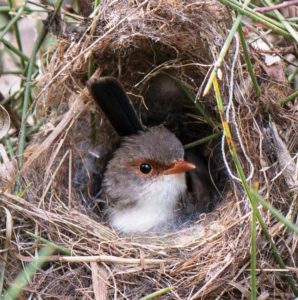
The chatter and motherly call of the Superb fairy-wren hen might sound like music to our ears but her complex solo song system has evolved to both train and protect her babies to be strong, safe and survive to adulthood.
Less conspicuous than her colourful male companion, whose mating and territorial chirps have ulterior motives, Flinders University Biological Sciences researchers are focusing on the female of the species to unlock the secrets of their vocalisation – casting new light on the powerful function of their birdsong.
The research findings have already surprised with embryonic recordings proving the pre-hatchlings learn their mother’s “incubation calls”, a series of two tones that are repeated to train the most-fit embryos to successfully beg for food after hatching.
In new research, published this month in the Royal Society’s Biology Letters, Flinders scientists have now linked the more varied maternal “chatter song” of female blue wrens (Malurus cyaneus) with the role it plays in further educating the young but with some lethal consequences.
Not only do these more varied vocalisations communicate with young while away from the nest, but the females’ chatter while in the nest can attract unwanted attention from predators such as ravens and currawongs. Predation of nests is one of the biggest risks to the birds in the wild.
“Our latest study provides the first explanation for why females sing less frequently than males: not because their song is less important but because female song attracts predators to the nest,” says Flinders University Professor in Animal Behaviour Sonia Kleindorfer.
“For decades scientists overlooked female song because it was perceived as being infrequent and was condescendingly considered a by-product of selection for male song,” says Professor Kleindorfer, who is Scientific Director of Flinders Research Centre for Climate Adaptation and Animal Behaviour.
“While naturalists focused on colourful males and loud male-male contests, female song was not thought to have any real purpose on its own. It was ignored.
“But we are finding that they do sing – and they are very clever about it – because mothers balance the needs of egg and chick care with vocal tutoring.”
Female songbirds tailor their vocalisation to fulfil their role as the main caregiver as they provide most of the parental care (egg laying, tending eggs and newly hatched chicks).
The Flinders University study has identified two vocalisations: the incubation call and the chatter song. The incubation call consists of two elements repeated ~5 times for ~1 second; while a chatter song in this species consists of 8 elements each repeated ~10 times for ~3 seconds.
“Both these ideas are new to science for songbird females. This research is giving females a voice,” says Professor Kleindorfer, who juggles her own parenting responsibilities with her academic and research work on native species and endangered birds in the Galapagos and Pacific islands.
“Yes, females sing less than males (on average) but this is not because they can’t sing or don’t want to sing,” she says.
“Rather, the constraints of parental care would make it unwise to sing too much yet still these females are able to vocally tutor the kids.”
Professor Kleindorfer and fellow Flinders School of Biological Sciences researcher Christine Evans, have co-authored the new paper, Female in-nest chatter song increases predation, and also collaborated on a new paper entitled Superb fairy-wren sons and daughters acquire song elements from mothers and social fathers (for Frontiers in Ecology and Evolution).

